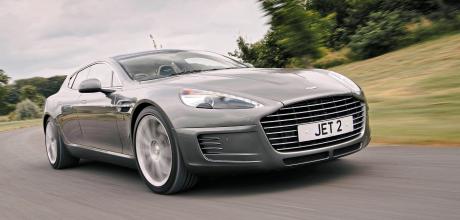2012 Bertone Aston Martin Rapide Jet 2+2
The Aston Martin Rapide Jet 2+2 could have given Bertone a new lease of life. Instead, it was the last car the great Italiandesign house ever created. Ten years on, we drive it.
Words SAM DAWSON
Photography STUART COLLINS
THE FALL OF GRUGLIASCO
Ladies and gentlemen, please approach the Bertone stand.’ In my 18 years so far as a motoring journalist, I have only attended the Geneva Motor Show once, in 2012. But I was still party to one of the great pieces of automotive theatre the halls of Palexpo so often played host to – the unveiling of a Bertone concept car. As the ex-Scorpions’ guitarist Uli John Roth played a wild riff, Lilli Bertone beamed as the covers came off the Nuccio. Named after her late husband, this Veuve Cliquot-orange wedge reputedly inspired by a crocodile’s head marked 100 years of the great design house, recalling icons like the Alfa Romeo 33 Carabo and Lancia Stratos Zero.
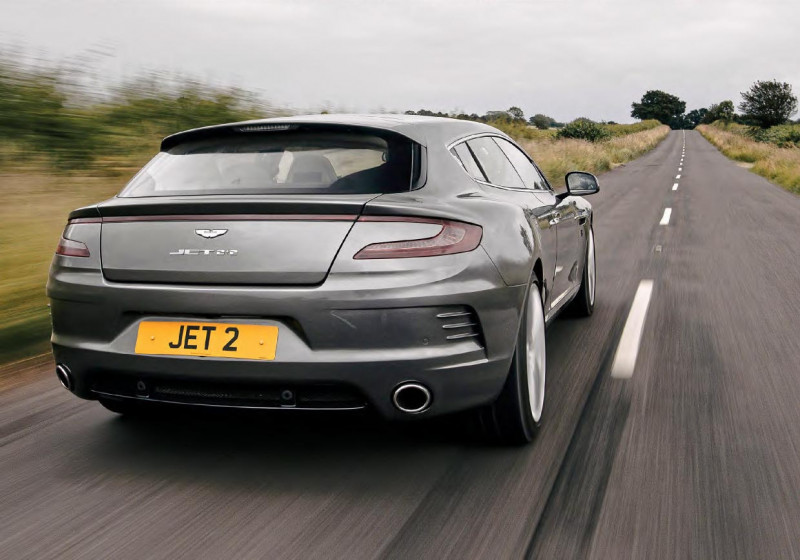
‘The V12’s constant growling, spiking into yelps under acceleration, is deeply satisfying’
And yet, despite being in the midst of a renaissance of traditional Italian coachbuilding that saw the likes of Carrozzeria Touring and Zagato return to prominence with handbuilt limited-run supercars, a year later Bertone closed the doors of its Grugliasco atelier for the last time. We were in a different automotive world, dominated by big manufacturing conglomerates. Design houses were being bought up or supplanted in-house by these giants and production could be outsourced anywhere. Bertone, for so long sustained by contracts to build as well as design Fiats and Opels, was left out in the cold. No mass-market contracts meant oblivion. Its hallowed collection of concept cars was sold off to museums. But just before the last light flickered out over the drawing boards, one final car escaped from its studio – and today I’m driving it, its snarling V12 propelling it over Leicestershire’s undulating rural tarmac just west of Mallory Park. The Bertone Aston Martin Rapide Jet 2+2 is a flamboyant shooting-brake based on Aston’s DB9-derived saloon. Being the brainchild of one determined enthusiast, it’s no bodged show-car either – this is a fully-functional and well-travelled vehicle.
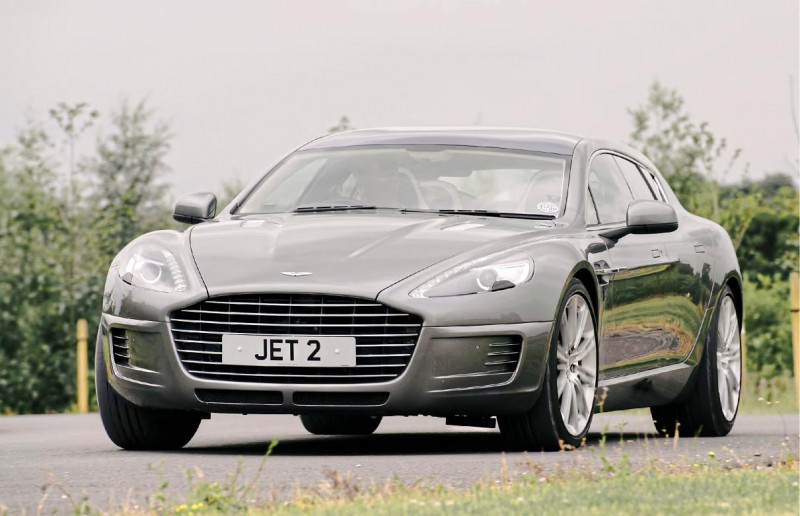
It was in 2009, at the car’s second showing at Geneva, when Barry Weir first saw Jet 2 in the metal. Weir is a lifelong Aston enthusiast who became the first person to circumnavigate the globe in a historic car – a DB2/4. ‘I asked the people on the stand if it was for sale and was told, “No, it’s Lilli Bertone’s car,” says Weir. ‘I wanted to ask if they’d consider building another one for me, but I didn’t actually know anyone at Bertone. And then, in October 2012, I received a phone call out of the blue from Bertone, asking, “Would you like us to build you a Jet 2?” ‘However, I couldn’t actually view the original car at that time.
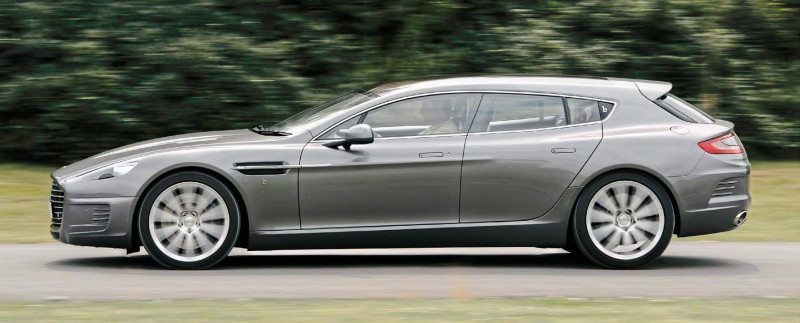
I met Bertone’s sales director at Marco Polo Airport in Venice for two hours in November 2012, and we sketched out some ideas on the back of airport café serviettes. My idea was for an Aston Martin shooting-brake, and the new Rapide was judged to be the best basis on which to build it’.
Aston Martin chief designer Marek Reichmann was then brought into the design process, meeting his Bertone counterpart Adrian Griffiths at Aston’s Gaydon factory. As a result, this car is the first to sport the larger grille that would later distinguish second-phase Rapides. But before the building process for the car commence in earnest, Aston Martin’s directorof sales, Marcus Blake, had to get approval from the board of directors to release a Rapide for Bertone to rework.
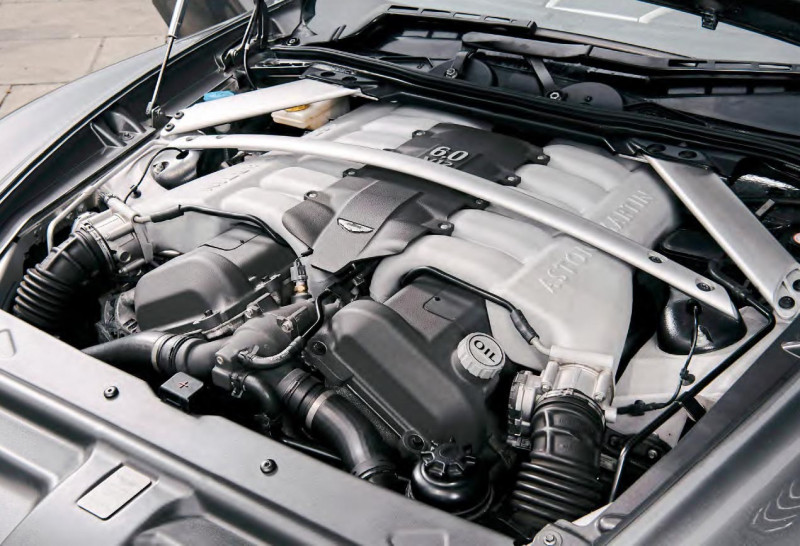
In an era of mass-produced rationality, reading Weir’s list of requirements for that sense of usability harks back to an earlier, more flexible era of bespoke one-offs and separate chassis. His wishlist included a centre console that’s sufficiently wide and flat to support a writing pad while jotting down notes, a panoramic glass roof, and room for four adults, including more headroom than the standard factory Rapide, and redesigned, slimmer front seats to yield more rear legroom.
As a combination, it works superbly. The smell of the leather in here – supple Italian hides rather than tough, saddle-like English ones – is intense. The driver’s door is surprisingly hefty, and the car seems intent on telling its special story via a dashboard plaque and another reminder of a 100th anniversary – this time Aston’s – on the sill plates. The dashboard features Lilli’s signature, in the manner of Nuccio’s gracing so many greats and familiar to legions of X1/9 owners.
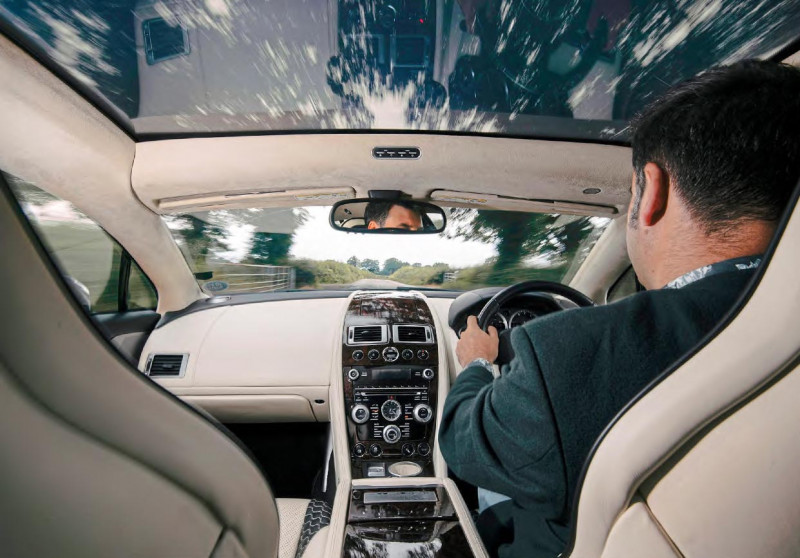
The dashboard-set push-button automatic transmission from the Rapide is oddly reminiscent of a Fifties American land-yacht rather than a post-Millennium British grand tourer, but it’s wonderfully clear and far friendlier to use than the Vanquish’s tricky automated-sequential manual. There are shift paddles on the steering wheel, but they’re overrides for a conventional automatic, and thankfully unobtrusive.
The 6.0-litre V12 fires up with a meaty burble, and despite this being a luxury five-door, remains vocal especially from the outside. I do find myself wondering whether a Jaguar-style whispering-turbine approach would suit it better, but to be frank the V12’s constant growling, spiking into yelps under acceleration, is deeply satisfying and I’d have to question my car-enthusiasm if I didn’t admit to enjoying it. It brings a touch of supercar to an otherwise serene world.
The odd distant creak betrays the car’s handbuilt origins as it negotiates rough tarmac at low speeds. As I manoeuvre the car onto the road, I catch sight of its wide rear wings in the door mirrors, aluminium hindquarters flaring outwards and upwardslike a Ferrari Testarossa’s. It’s a reminder of quite how bespoke this car’s specification is. Although at first glance it resembles a regular Aston Martin Rapide, the only panels it shares with the standard production car are the front wings and front doors.

The grille and its surrounds are inspired by Aston’s roadgoing One-77 supercar, the rear wings conceal massive 295/35 ZR20 tyres, and the extensive use of glazing is a departure. The roof uses Italian-made Icolima Cromalite glass, which becomes opaque when an electrical current is passed through it. A pair of buttons by the rear-view mirror allow you to switch between opaque hardtop cocoon effect and massive transparent skylight.
Had such technology been available for the Lagonda of the Seventies, you can bet it would’ve had one of these. Pleasingly for a sporting automatic, the brake pedal is sufficiently wide as to fall naturally by my left foot, making kartstyle two-footed control easier than a hip-straining twist into the middle of the footwell. At low speeds there’s a contrived weight to the wheel’s power assistance, seemingly devised to convey the car’s heft and solidity, perhaps at the expense of manoeuvrability. Sadly, this also robs it of feel at higher speeds, although the numbing width of the 245/40 ZR20 front Bridgestone Potenzas can’t help in that regard either.
What they do muster a lot of, though, is grip. The front end sticks hard to the road, changing direction immediately with a nudge of the wheel, revealing less nose-bob than a Vanquish. However, at higher speeds the tyre roar fills the cabin, drawing my attention to those door mirrors again, and the bulbous rear end. It’s a big GT for long drives from port to ski lodge, not a sports car for quickly nipping-and-tucking through narrow gaps at speed, even if it feels an urge to do so somewhere in its genes. It’s at its most refined between 1000 and 3000rpm, when the V12 quietens down a little, coinciding with relaxed motorway cruising speed in top gear. At just 3500rpm though, right foot buried in the carpet, there’s a sudden surge, a Vanquish-style whipcrack from the exhausts – and all of a sudden the Jet is doing its best impression of a supercar.
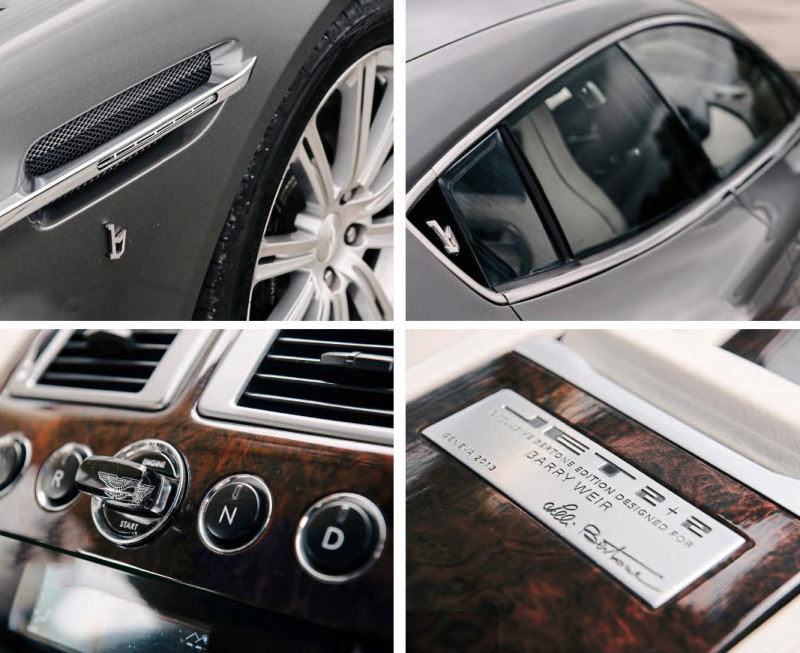
Despite the drama, it does everything smoothly, though. Huge brakes add confidence, easily reining the car in when the roads get tighter. However, it’s not user-friendly to the point of blandness – it’s still a challenge to pilot at speed, not helped by the bespoke centre-console casting odd reflections on the shallow-raked windscreen. But minor niggles aside, it’s a superbly cohesive piece of design and engineering.
And not just in the way it drives. Prodrive, which owned Aston Martin at the time, completely re-engineered the rear of the car, with rear seats that split-fold unusually halfway up the seatbacks, and ridged luggage racks electrically extending over the top of them to accommodate large loads. I’m reminded of the long tradition of short-run Aston Martin estates from the likes of Harold Radford and FLM Panelcraft, and a world of country-house clients with a need to accommodate their collections of dogs and shotguns. Given that such commissions continue to invigorate Touring and Zagato, could Bertone not have changed direction and joined them?
As the car came together in 2012, Aston Martin reached an agreement with Bertone and Weir that production of any Jet 2+2 replicas would need the joint approval of all three parties. Aston did consider a limited run of 10 – similar numbers to the DB5 and DB6 shooting-brakes of the Sixties – but all focus was on getting this one car ready for Geneva 2013. Weir finally saw the completed car for the first time on 23 April 2013, on the eve of the show itself, and only his second visit to Bertone. It would turn out to be the very last car to be ritualistically revealed in the Palexpo beneath the distinctive bent-B logo. Bertone formally entered bankruptcy proceedings on 18 March 2014, but it had been struggling for a while. Building Weir’s special Rapide kept the firm alive for 75 days more than it would have otherwise. After the proud boldness of the Nuccio reveal a year earlier, Geneva 2013 became a requiem.
And yet it’s a requiem that has a coda, then a reprise. In 2018, the contents of Bertone’s archives were auctioned off, and Weir discovered that they included the glassfibre moulds and full-size clay model of the Jet 2+2, required if any replicas were to be made. Weir made the auctioneers aware of the tripartite agreement between himself, Bertone and Aston, and they were withdrawn from sale and reunited with the car before being donated to the Aston Martin Heritage Trust. A letter from Aston confirms that ‘should you need the patterns to produce replacement parts or exercise your rights to licence additional versions of the vehicle, we will release any required patterns to a person of your nomination. Should the vehicle be sold we will honour the same terms with a new owner.’ Perhaps it won’t be the last Aston Martin Jet 2+2 after all?
And, even more remarkably, Bertone might even build it. Rather than dying with the design house, the rights to the brand were licenced to a Milanese architect, then industrial design concern AKKA Holdings, which relaunched the design house and hired a chief stylist, former Bertone staffer Carlos Arroyo Turon, before selling the revitalised firm to Mauro and Jean-Franck Ricci.
And last year, the company unveiled the GB110, a radical supercar to celebrate 110 years of Bertone. Was the Jet 2+2 really Bertone’s swansong, or merely the sole car to emerge from an otherwise barren decade? Only time will tell now...
TECHNICAL DATA 2012 Bertone Aston Martin Rapide Jet 2+2
- Engine 5935cc V12, dohc per bank, sequential multi-port fuel injection
- Max Power 470bhp @ 6000rpm
- Max Torque 442lb ft @ 5000rpm
- Transmission Six-speed automatic, rear-wheel-drive
- Steering Power-assisted rack and pinion
- Suspension Independent, double wishbones, coil springs, telescopic dampers and anti-roll bar front and rear
- Brakes Discs front/rear, servo-assisted
- Performance Top speed: 184mph;
- Acceleration 0-60mph: 5.3sec
- Weight 2065kg (standard Rapide, Jet 2+2 never measured)
- Fuel consumption 19mpg
- Cost new n/a Classic Cars Price Guide n/a
‘Perhaps it won’t be the last Jet 2+2 – and, even more remarkably, Bertone might even build it’
Power and torque written all over it Bertone’s mark adorns details throughout Plenty of room for dogs and shotguns here. Rear seats split/ fold halfway up the seat backs.
Panoramic roof can be dimmed using buttons Mix of design and engineering is pure drama. Redefined roofline affords rear passengers more headroom Snug-fitting V12 provides a hearty 470bhp.
Plaque tells this bespoke oneoff’s story Bertone skilfully reworked the glazed apertures Aston-style strakes, with Bertone twist Base car’s dashset auto’box controls ret. Unique shootingbrake is based on the Aston Rapide.
‘The brainchild of one determined enthusiast, it’s no bodged show-car – it’s fully functional and well travelled’
Bespoke cabin features supple Italian leather.
OWNING THE BERTONE JET 2+2 – ADRIAN BURR
‘Barry Weir did 17,000 miles round Europe, and his daughter’s wedding, with the Jet 2+2 before deciding to move it on,’ says Adrian Burr. He bought the car from its commissioner and original owner to join his collection, which includes bespoke coachbuilt Lagonda Rapides from the Thirties. ‘I got a phone call from Aston specialist Desmond Smail, saying, “Guess what I’ve got? Something quirky, but that’s right up your street. Would you like to drive it?” Apparently, if he couldn’t sell it to a trusted collector, Barry was considering giving it to Aston Martin Heritage.
‘I did wonder what might happen if I crashed it, until I found out that ownership included rights to the moulds. So I use it – I drove it to Villa d’Este this year, took it round Monza, and to the Le Mans Classic. It’s what it’s for, after all. But it’s also a unique Aston Martin and the last car to be built by Bertone, so if it wasn’t owned by someone who kept it running, it’d inevitably end up in a museum.’


